NOW UPDATED! This post was updated with more in-depth content, templates and examples on how to craft the perfect buyer persona. Enjoy!
Do you feel like your marketing campaigns are falling on deaf ears?
No matter how hard you try, or how top-notch your campaign copy is, nobody is responding. And even worse: nobody is purchasing — which means you’re wasting precious revenue on marketing strategies with low ROI.
There’s no denying that we live in an ad-heavy world. Today’s businesses have to break through an impressive amount of noise in order to capture a prospective buyer’s attention.
In fact, some experts estimate that we’re exposed to as many as 4,000-10,000 marketing messages every day, making it harder than ever to get your organic marketing into the eyes and ears of the right people.
It’s no surprise that consumers are more likely to trust recommendations from people they know or even customer reviews, as opposed to advertising:
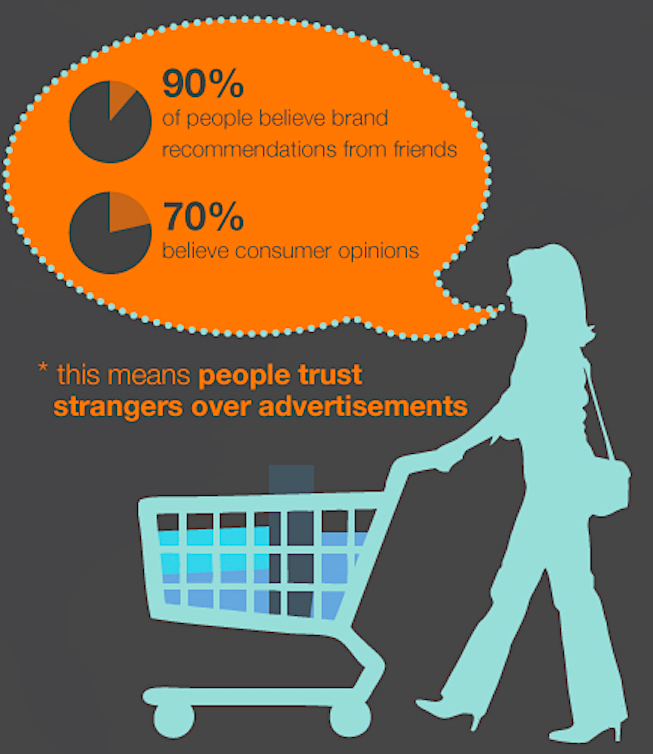
A friend with our best interest at heart, for example, will almost always be able to offer a more persuasive endorsement than a marketer whose sole reason for convincing others to buy is that his or her livelihood depends on making this sale. Not only that, but when friends and family provide referrals, the words and phrases they choose will naturally be tailored to what they know of our own preferences.
As a marketer, you need to rely on testing different messages for different audiences to increase sales. But don’t take a stab in the dark and assume you understand the people you want to attract.
If you want to have the best chance of getting the attention of prospects in an ad-heavy world — and, more importantly, convince them to buy from your company — you’ll need to build buyer personas.
What Is a Buyer Persona?
First up, let’s discuss exactly what a buyer persona is.
Here’s the simple definition: A buyer persona is a detailed description of your target customer. It’s a document that lists everything from demographic information to hobbies, and from career history to family size — all written as if the persona were a real person.
Here’s an example:
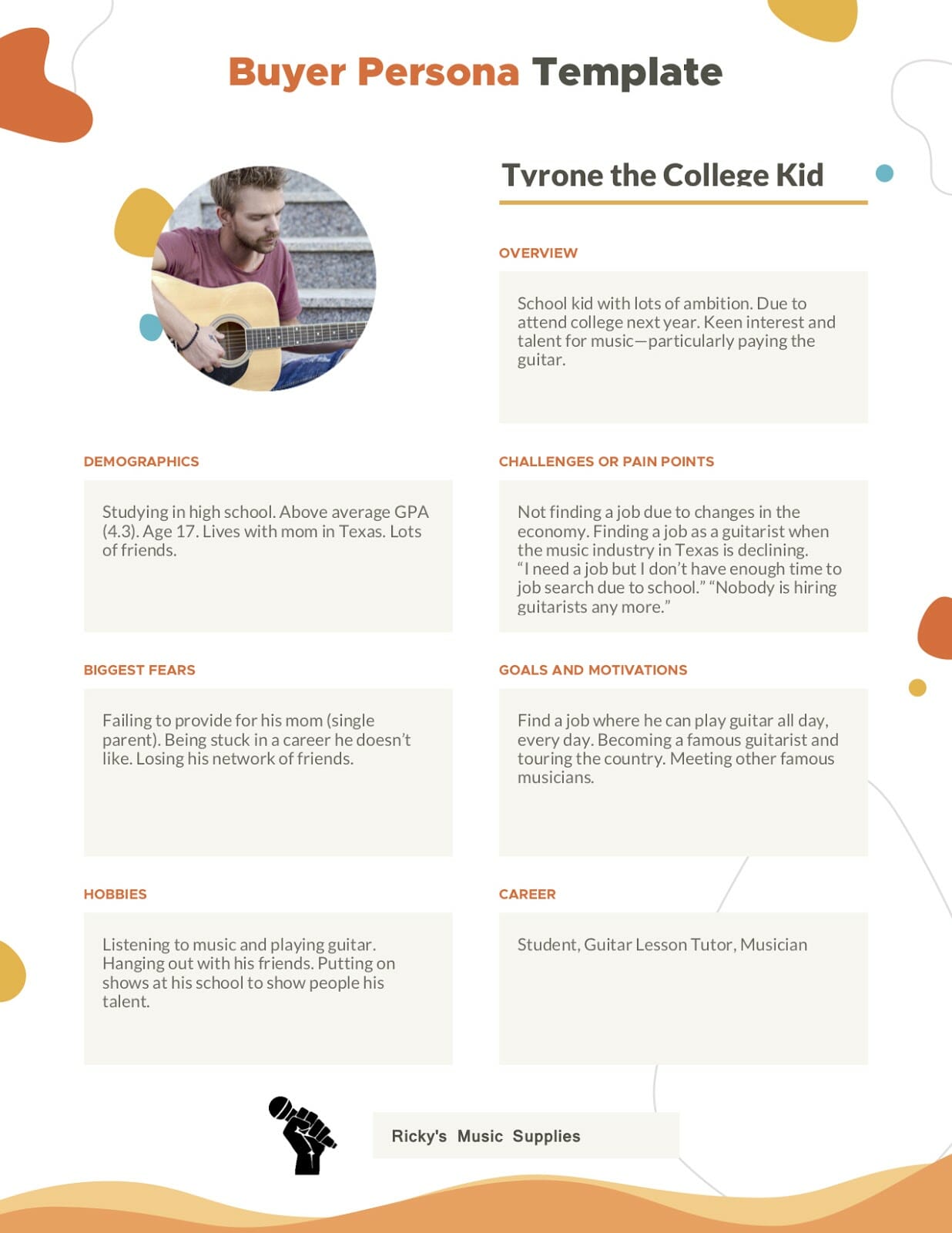
If this seems like an actual description of a real person, that’s because the brand or the marketer did their research.
You might be wondering why you should bother creating buyer personas, since it looks like a lot of work. The answer is simple: With detailed buyer personas, you have a clearly defined target customer.
Knowing them inside and out — including the motivations they have or the problems they’re struggling with — allows you to tailor your marketing messages to speak directly to the people whom you want to buy your products or services. Similar to a friend who vouches for a certain brand of sneakers, you will understand exactly what might matter to your buyer and convey the message in a manner that a personal friend might use. In other words, you take the guesswork out and stop shooting in the dark with your fingers crossed.
It’s no wonder that 71% of companies who exceed revenue and lead goals have documented buyer personas.
Dive Deeper:
- The Science of Building Buyer Personas (infographic)
- 4 Steps to Discover Your Ideal Buyer Persona for B2B Marketers
Do Buyer Personas Really Work? (Case Study)
Travel brand Eindhoven365 decided they needed a stronger understanding of the people they were targeting through their marketing campaigns. They wanted to learn the decision-making behavior of three key segments:
- City Explorers who visit Eindhoven
- Bright Talent who study and work in the city
- Tech Starters who establish and scale innovative businesses there

By working to understand each segment through research, analysis and dozens of in-depth interviews with target audience representatives, they found valuable insights about each of their segments and the tactics needed to reach them.
For example, here’s what they discovered about Tech Starters:
- They’re tricky to convince to relocate, meaning that lead nurturing is vital.
- They care about the politics and economic stability of the country, so the marketing campaigns need to highlight and solve this.
- They crave motivational support, so connecting them with leaders is beneficial.
Eindhoven365 is now using their buyer personas to power “inbound marketing program, formatting content, search marketing and the implementation of marketing automation software.”
Buyer personas inform everything you do, from the words you use on the phone to the content you post on your website, with one aim: to deliver the sales pitch that will be most persuasive to a particular buyer’s personal situation.
Marketers who are sending advertising messages into the void without knowing the exact wants, needs, preferences and experiences of their target customers must resort to vague and general language in their ads in the hopes of connecting with at least a few recipients.
Since persuasive messages result in more sales and revenue for your business, it’s definitely worth your time to create and implement buyer personas as part of your marketing strategy. Share on XHow to Create Your Own Buyer Personas
Are you ready to take advantage of buyer personas and start driving more sales through your marketing campaigns?
Spoiler alert: It takes more than “spying” on your ideal customers to understand who they are. You’ll need to know everything about them to ensure that your documents are built on concrete data rather than assumptions.
Here’s how you can create your own fool-proof buyer personas:
1) Learn About Your Customers
You can’t create marketing messages that appeal to your customers, nor build accurate buyer personas, if you don’t know what makes them tick. You’ll need to put in the work and learn all about them.
A concrete buyer persona contains the answers to the majority of these questions:
Personal Questions:
- What is the buyer’s gender?
- What is the buyer’s age?
- What is the buyer’s household income?
- Who lives with the buyer at home?
- Does the buyer live in an urban, suburban or rural environment?
- How does the buyer spend his/her day?
- Who does the buyer look up to?
- What does the buyer read for fun?
- What does the buyer do for fun?
Work-Related Questions:
- What level of education has the buyer achieved?
- What type of company does the buyer work for?
- What is the buyer’s role/title in the company?
- What are the buyer’s biggest challenges at work?
- How does the buyer define success in the workplace?
- What are the buyer’s career goals?
- What are the buyer’s biggest fears (or “pain points”)?
- What are the buyer’s most common objections?
- How can your product or service help solve the buyer’s challenges?
- How tech savvy is the buyer?
- Which social networks does the buyer prefer?
- How does the buyer prefer to communicate?
As you might expect, the specific questions for which you’ll need to find answers will vary. For example: If your product or service doesn’t involve technology, adding the question about your buyer’s tech expertise may be unnecessary.
But how do you find the answers to those burning questions? You could:
- Survey existing customers: You can learn a lot about your target audience by sending questionnaires to your existing customer base and finding out what makes them tick. You might need to offer a small incentive (like a coupon or free sample product) to convince them, but their answers will be valuable for your buyer persona research.
- Invest in one-on-one interviews: If you have the budget to do so, investing in focus groups or one-on-one interviews with your existing customers can provide great data for your buyer personas. You might be able to spot unique pain points, challenges or motivations that are unique to your product or service.
- Check your analytics: Analytics programs can provide you with demographic data about the people who are currently interacting with your site and your social profiles, such as their location, age or device. Tools like Leadfeeder and Lead Forensics can also shine a light on the anonymous traffic visiting your site.
- Talk to your employees: Your customer-facing employees likely have a wealth of information about the customers they deal with – but you won’t know unless you ask! Run the questions listed above by your sales team and collate their answers. If you spot something occurring regularly, add it to your buyer persona.
- Use the Clearbit Enrichment Program: This is an excellent tool that builds a persona with 85 data points out of any email or domain name and will help answer any of the questions above. It can also be used to streamline the process and save time.
The most important thing to remember when creating buyer personas is that you should never assume. Guessing that your customers are millennials when they’re actually aged 50+, for example, could throw off your online marketing campaigns drastically because you wouldn’t target them in the same way.
Granted, investing in buyer persona research can be a big investment — especially if you’re incentivizing customers to take part in your surveys — but having that concrete data, rather than a bunch of guesswork, is bound to save cash in the long run.
Dive Deeper:
- 3 Ways to Personalize the Customer Journey Experience
- Buyer’s Journey 101: What Your Email Data Says About Your Customers
- How to Optimize Your Content Strategy with the Buyer’s Journey
2) Determine How to Segment Your Customers
Now that you’ve collected the answers to your buyer persona questions, it’s time to put your customers into groups.
If you’re a bit confused, don’t worry. It’s not uncommon for your answers to vary dramatically, which is why you’ll need to create separate buyer personas for the different groups of people you sell to.
For example: Mark offers website design services to businesses. When reaching out to new prospects, he tends to encounter two different types of customers:
- Older management who have been in the business for decades and aren’t readily open to new ideas. They usually care more about delivering excellent service to improve their bottom line than marketing.
- Up-and-coming entrepreneurs and small business owners with an interest in new technology. They’re usually millennials and eager to stay ahead of the curve.
From experience, Mark has discovered that these two groups respond to very different sales approaches.
The older managers aren’t that comfortable with the Internet and aren’t concerned about making sure their websites look up-to-date. However, they do care a lot about their bottom line, so they respond well to pitches that emphasize how important a modern-looking website is to attracting and retaining new clients.
The younger segment, on the other hand, isn’t as concerned with the bottom line of their practices. But, having grown up around computers, they’re anxious to get their hands on the newest web technology.
In this case, Mark has two distinct target customers:
- The older manager with more experience
- The young, tech-savvy entrepreneur
Mark should create two buyer personas – or detailed descriptions from sample customers – based on these profiles. Why? Because segmenting the qualities for each buyer persona, rather than jumbling them all into one, allows Mark to tailor his future marketing campaign messages as closely as possible to the needs of each segment. Talking too much about technology might alienate the older manager, and talking too much about bottom lines might frustrate or bore the younger business owner.
You might not even realize that you have more than two target customers until you start putting this into practice for your business.
It’s predicted that 3-4 personas usually account for over 90% of a company’s sales, but regardless of whether you have one or many, the key is to make sure that your buyer personas are as accurate (and defined) as possible.
Dive Deeper:
- Segmentation 101: A Strategist’s Complete Guide to Marketing Segmentation
- 7 Segmentation Mistakes That Are Costing Your Business Money
3) Create Your Own Buyer Persona Template
Great job! You’ve got answers to your sets of questions, and you’ve got your information divided into the types of customers you have. Your job isn’t over yet, though; now it’s time to put your personas together.
Downloading our free buyer persona template is the easiest way to do this. All you’ll need to do is type the qualities that your ideal customers share into the template! Click below:
Let’s put that into practice with our example of Mark, the website designer.
Mark goes through the questions above, combining his own insights with the information he gathers by interviewing past customers, and comes up with the following two buyer personas:
Maggie Manager
- Overview: Supervises a team of 15 people at Recruiter Firm. Completed her undergraduate degree in Management in 2005.
- Demographics: Female. Age 40. Annual income $63,000. Lives in Colorado with three young children.
- Challenges or pain points: Standing out from other recruitment companies. Staff retention.
- Biggest fears: Being fired because her firm isn’t profitable. Losing one of her best recruitment advisors to a competitor.
- Goals and motivations: Work for one of the best recruitment firms in the USA. Finding top-quality candidates for her clients. Achieve a salary of $100,000 to send her children to private school.
- Hobbies: Motivating her team. Outdoor activities such as hiking or cycling. Taking vacations with her mother.
- Common objections: “I’d love to pay for a modern and responsive website, but our boss won’t allow the budget.” “Our boss thinks our recruitment guy, who builds Tumblr websites in his own time, can design our website for free.”
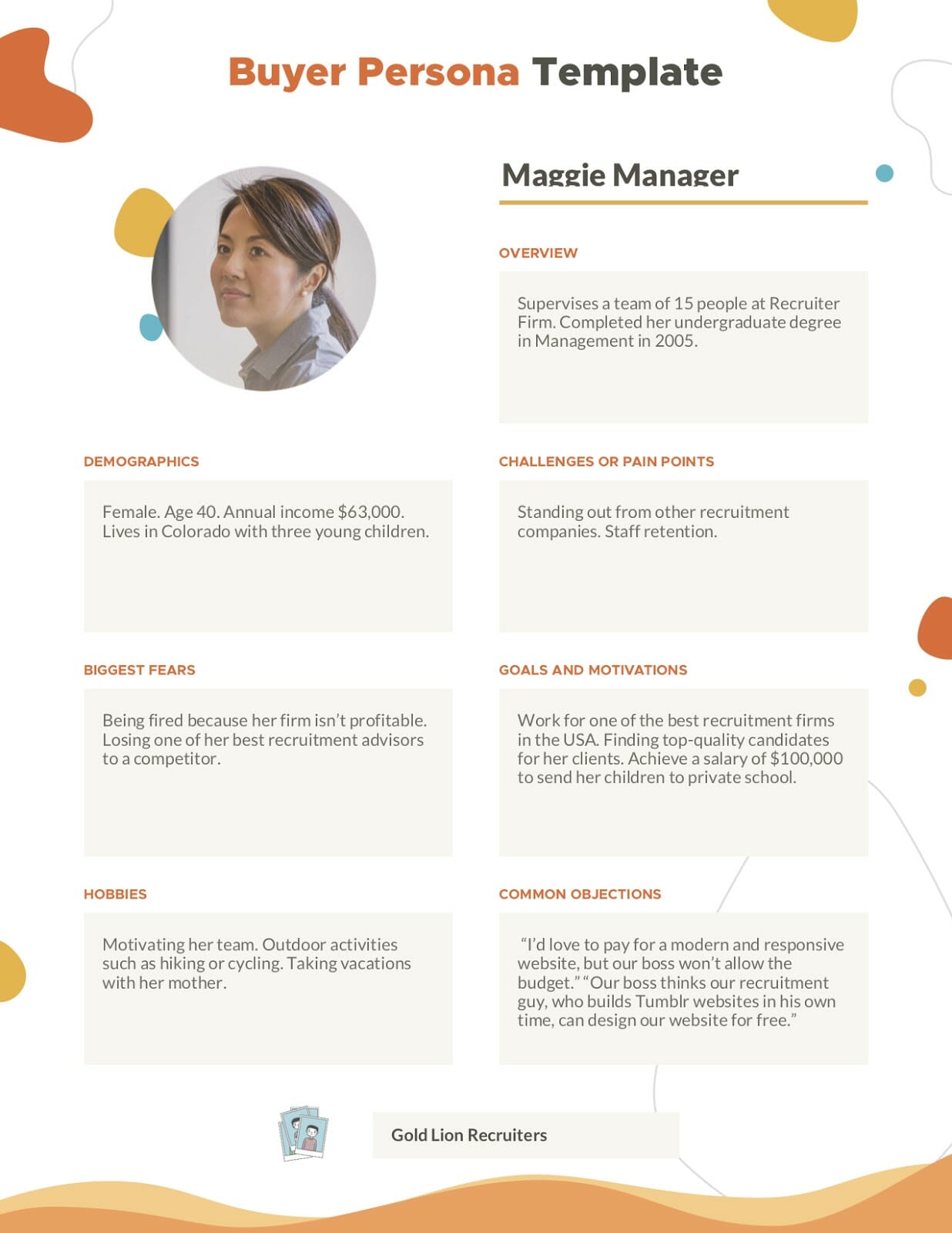
Eduardo Entrepreneur
- Overview: Always on the go and thinking of new business ideas. Doesn’t have any full-time staff. Owns five businesses, but always wanting to start another.
- Demographics: Male. Age 22. Lives in San Francisco with his parents and younger sister. No formal education.
- Challenges or pain points: Creating a website on a small budget for each new business. Focusing on one business at a time. Unsure whether a website designer is worth the investment because he’s been ripped off in the past.
- Biggest fears: Feeling like he’s falling behind, and failing at being a “young entrepreneur.” Wasting money.
- Goals and motivations: To earn $500,000 per year within the next five years. To start a well-known technology company similar to Uber or Amazon. Earn enough money for his parents to retire and his sister to go to college.
- Hobbies: Networking with other young entrepreneurs. Speaking at local schools to tell his story. Writing a blog to share his progress as a founder.
- Common objections: “I’d love to pay for a website that stands out from other technology brands, but my business is new and I don’t have much cash left over.”
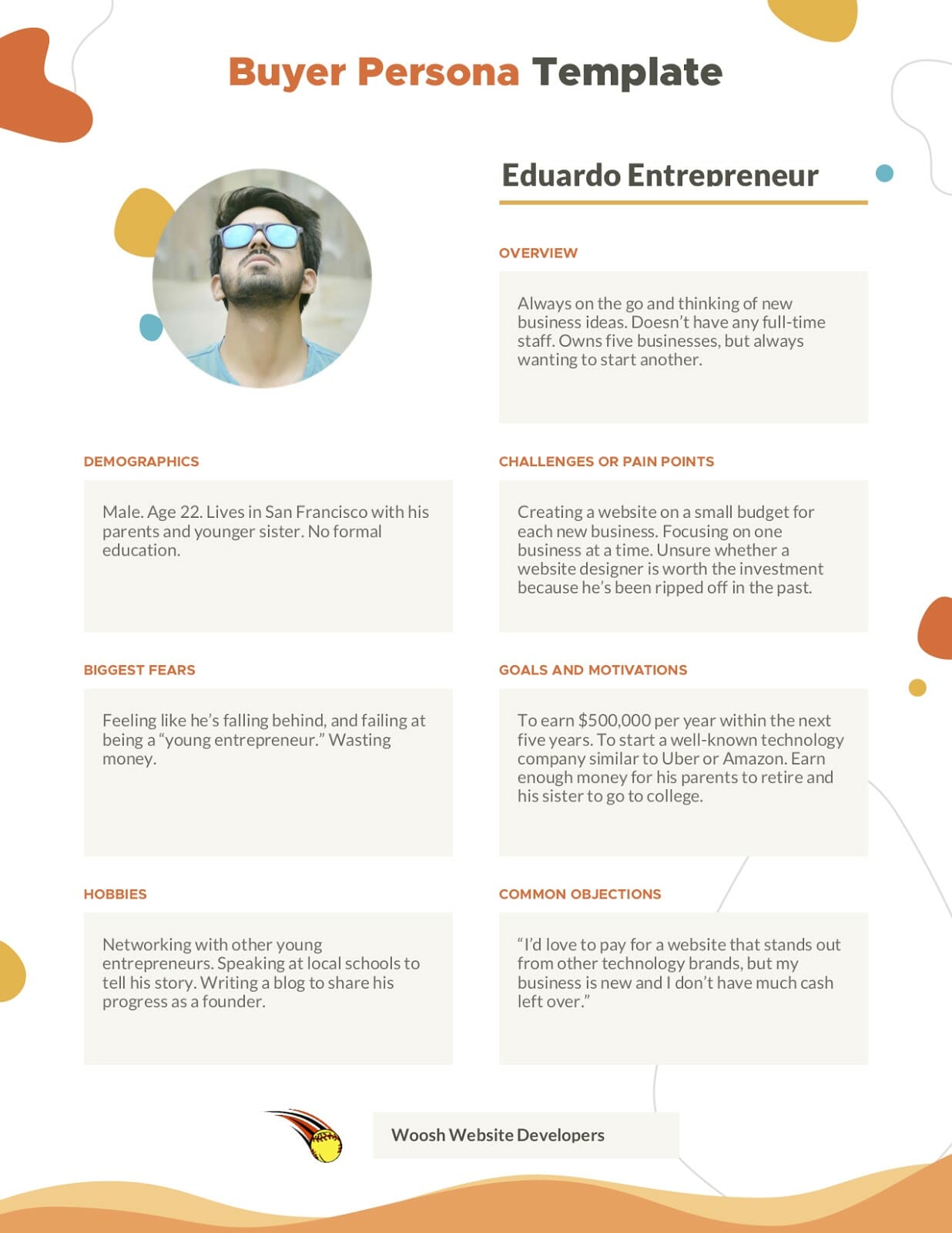
Notice how each of Mark’s buyer personas tells the story of a different person?
If he’d lumped them all into one, his targeting wouldn’t be as accurate. But by splitting them up, he can analyze which marketing campaigns attract each type of customer.
Dive Deeper: Top 8 Tools to Improve Customer Experience Using Heat Maps, Feedback and Links
4 Ways to Use Your Buyer Personas for Better Marketing Campaigns
You’ve got your buyer persona documents down to a T, but now that you’ve put in all this effort to create them, don’t just leave them to float to the bottom of your Google Drive, never to be seen again.
Put them to use — and start improving your marketing campaigns instantly — by following these steps.
1) Identify Prospects by Persona, Right from Your First Interaction
In order to use your buyer personas effectively, you’ve got to develop methods for classifying prospects accordingly. That way, you’ll be able to tailor everything from your sales pitch to your marketing materials as closely as possible to the type of prospect you’re dealing with.
Remember: buyer personas are the key you’ll need to unlock uber-specific customer targeting and speak to them in a way they’ll convert. One of the easiest ways to do this is to ask prospects a clarifying question (or series of questions) during your first interaction with them.
Let’s take Mark’s example from above and imagine that he’s dealing with a manager who’s called his business to inquire about website services. Since Mark doesn’t yet know what kind of prospect he’s talking to, one of the first things he should ask is: “What is your biggest problem with your current website?”
If the prospect responds that she’s having trouble capturing business leads, Mark could assume that he’s talking to a “Maggie Manager” persona and adjust his sales pitch to focus on the financial advantages of having a new website.
If the response is that the firm’s current site looks out-of-date, he could hone in on the features that his platform provides in order to appeal to an “Eduardo Entrepreneur.”
A few other clarifying questions that could help identify different buyer personas include:
- What one thing are you hoping to get out of a solution like ours?
- What do you see as your biggest business challenge?
- How do you see our solution helping to solve your problems?
- Are you more concerned about [defining persona characteristic] or [characteristic of other buyer persona]?
- If I could help you with one thing, what would that be?
Take a look at how Dave Smyth, the brains behind web design company Websmyth, does this with one simple question on his contact form:

The “location/timezone” allows Dave to see where his customers live, and the “company” field gives Dave the opportunity to browse their company website — both of which give Dave the chance to determine whether a new inquiry fits into his buyer persona.
But even if you don’t have a way to add clarifying questions to your sales cycle, you’re not out of luck. You’ll just need to let your creative juices flow.
Could you run separate advertisements in your industry’s trade journal using different language/jargon that will appeal to each of your buyer personas? If you include a special promotional code that prospects must reference when initiating contact with your company, you’ll know which ad piqued their interest and, therefore, which buyer persona they’re more likely to fall under.
Ultimately, the specific classification methodology that works best for your business will depend on your unique sales funnel, marketing strategies and target customers.
There’s another caveat to this technique: Not all prospects will fall neatly into one of your buyer personas, and it’s possible that you’ll receive unexpected answers to your qualifying questions.
But don’t let this throw you. Gather the unexpected responses you receive to create future additional buyer personas and, in the meantime, classify the prospect according to the existing persona that’s closest in nature.
2) Track Leads More Effectively in Your CRM
If you go to all the effort of classifying your sales prospects into different buyer personas, it makes sense to track this information in order to nurture them through the marketing funnel. But a handwritten note scrawled on a scrap of paper mid-phone call isn’t the way to go.
It’s wise to use a CRM with a custom picklist field that allows you to select from your established buyer personas. That way, you can quickly glance at your customer list and know which type of marketing, communications or sales copy you’ll need to convert them.
You can do this in HubSpot, simply by uploading your buyer personas and using them to label every new lead:

You’ll then be able to run reports based on this data, including:
- Whether you’re generating more leads in one buyer persona than another
- Whether one buyer persona is resulting in more closed-won opportunities than others
- Which type of contact (email, phone, etc.) works best for each buyer persona
These types of reports can provide you with powerful marketing insights that could alter the way you spend your advertising dollars, as well as the specific methods you use to reach out to prospects.
The bottom line? Find a good way to record the buyer personas you’ve assigned to your customers and revisit the data you’ve collected at least once a quarter to see if reveals any insight that ultimately affects the way you market or advertise your business.
3) Send Different Personas into Customized Marketing Funnels
Classifying your prospects into buyer personas is great and tracking that information is important, but driving your different personas into different marketing funnels is the real reason you’re going to all this trouble in the first place, right?
As we’ve already discussed, knowing your buyer personas allows you to speak to them in a way that’s likely to resonate with their specific wants and needs.
And since each buyer persona likely has a preferred mode of communication, you can use this to create specific marketing funnels for each type of person you’re looking to convert into a customer:
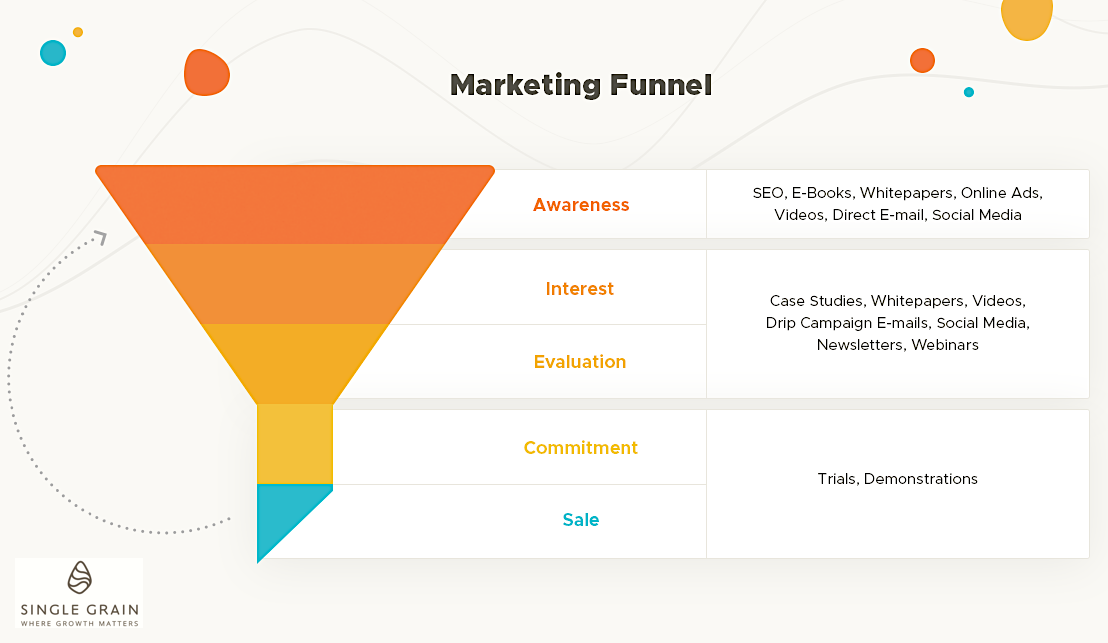
For example: Sales calls are one of the first places you’ll want to introduce persona-specific content since that’s likely a lead’s final interaction before converting. So create a set of sales scripts tailored to the wants and needs of each of your buyer personas.
Then, once you’ve used your clarifying questions to figure out which buyer persona your prospect falls within, switch to the appropriate set of script to use. This will allow you to have the most compelling possible sales pitch, designed specifically for that person and their needs.
Taking this a step further, here are some more ideas of how you can use your buyer personas to push leads down personalized marketing funnels:
- Reference blog content already written for each persona: Use your blog posts strategically by posting content that will appeal to each one of your buyer personas. Then, when you’re communicating with a prospect that you’ve sorted into a specific persona, you can reference individual blog posts that reinforce your sales pitch in an educational (yet persuasive) way.
- Alter responsive website content: Tools like HubSpot, Evergage or OptinMonster let you display personalized content based on the buyer persona you’ve assigned to your prospects. When your website detects their IP address during their visits, everything from alternate call-to-action buttons to entire blocks of content can be optimized to appeal specifically to the buyer persona interests or preferences you’ve already found.
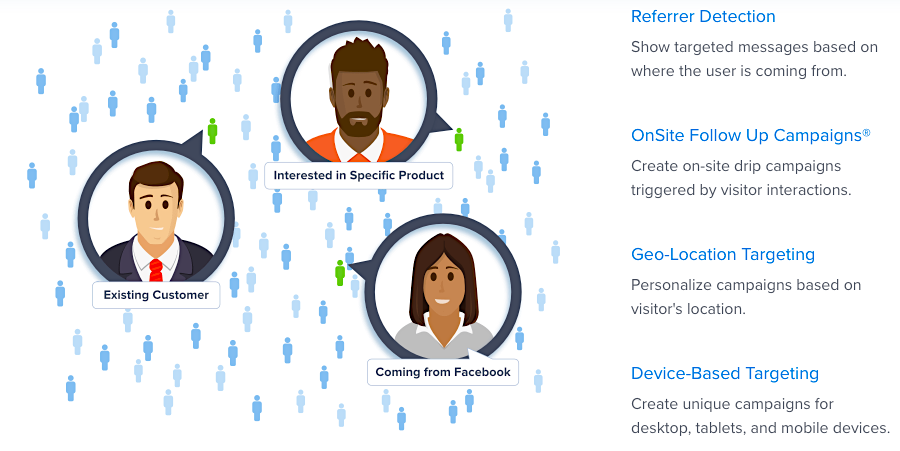
- Assign alternate nurturing drip campaigns: Personalized emails are 26% more likely to be opened and increase CTRs by 14% than broadcast emails. Take advantage by using buyer personas to trigger automation rules that place the leads into email campaigns — and tailor these campaigns to their personas and stages in the sales process.
Finishing up with our example of Mark the website designer, let’s see how he can tailor his phone calls to his two different buyer personas — rather than just giving out a “one size fits all” sales pitch:
For Maggie Manager:
Mark: Hi there. My name is Mark from Websites 4 Everyone. I’d love to talk to you about how our streamlined website management system can help your firm meet its business goals.
Maggie Manager: Sure, I’ve got a few minutes.
M: Great! Let me start by asking: What would you say is your biggest problem with your current website?
MM: Well, I don’t really know much about websites. I just want something that looks good and will help my recruiting firm get more clients.
M: I definitely understand. Having a website is important, but it needs to represent a positive investment for your firm. I’d love to show you how some of my past customers have used their websites to capture new business and increase their overall revenue.
For Eduardo Entrepreneur:
Mark: Hi there. My name is Mark from Websites 4 Everyone. I’d love to talk to you about how our streamlined website management system can help your firm meet its business goals.
Eduardo Entrepreneur: Sure, I’ve got a few minutes.
M: Great! Let me start by asking: What would you say is your biggest problem with your current website?
EE: Well, my website looks incredibly dated. I wish I could get something new to impress my clients who are up-to-date with design and technology, but I don’t have a big budget.
M: I definitely understand. Having a website is important, but it needs to look modern if you want potential customers to take you seriously. I’d be happy to show you how my past customers have taken advantage of our system’s high-tech features, and I can show you several options at various price tiers.
Dive Deeper:
- How to Create the Ultimate Marketing Funnel (Templates Included)
- How to Guide Your Customers Through the Marketing Funnel with Interactive Content
- How to Build a Facebook Chatbot Marketing Funnel
- How to Build a Social Media Marketing Conversion Funnel
- How to Set Up Marketing Funnels (TOFU, MOFU & BOFU)
- Retargeting 101: Why It’s Essential for Any Marketing Funnel
4) Use Buyer Personas to Find the Perfect Marketing Channel
You’ve used your buyer personas to take leads from stranger to customer.
But it’s not just lead nurturing that buyer personas can help you improve; you’re able to use your buyer persona documents to find new customers and constantly push them through your marketing funnel and towards a purchase.
How? Because after understanding your buyers and where they hang out, you’ll get a better sense of the channels that will work best in advertising or marketing to them.
For example: 72% of U.S. teens use Instagram, making it a great marketing channel if your buyer personas are under the age of 20. But when you combine that with influencer marketing (since 70% of teens relate to YouTube vloggers more than traditional celebrities), you might struggle to identify the best influencers who will reach your targets.
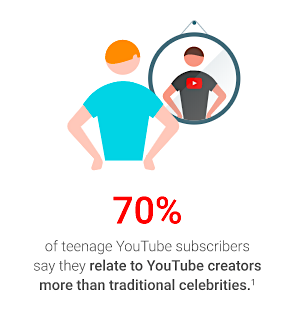
Enter: Your buyer personas. Again.
Using buyer personas gives you a source to discover common interests and discover the influencer that your buyers already follow and trust. Share on XThat’s because your document will already have the answers to these questions:
- What does the buyer read for fun? (e.g. In the Frow blog)
- What does the buyer like to do for fun? (e.g. watch fashion-styling videos on Instagram)
- Who does the buyer look up to? (e.g. fashion bloggers like Victoria McGrath, Jenn Im or Lydia Rose)
Which makes it easy to not only identify Instagram as a superb platform for marketing, but to find influencers who your teen audience takes notice of.
Final Thoughts
Buyer personas are more than just a foundation for higher ROI and target marketing. They help you understand your customers and, more importantly, how your product or service best suits them.
At the end of the day, the goal of developing and assigning buyer personas is to be able to humanize your sales content and marketing messages. So, once you’ve created your buyer personas, integrate them with your sales and field teams, and allow everyone to not only to help track the buyer persona data, but make the most out of them as well.
You’ll substantially increase the likelihood of your advertising and marketing messages hitting home — and turning into sales, as a result.




